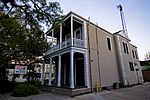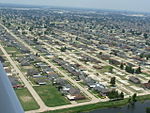WDSU
1948 establishments in LouisianaHearst TelevisionMeTV affiliatesNBC network affiliatesTelevision channels and stations established in 1948 ... and 2 more
Television stations in New OrleansUse mdy dates from January 2012

WDSU (channel 6) is a television station in New Orleans, Louisiana, United States, affiliated with NBC and owned by Hearst Television. The station's studios are located on Howard Avenue in the city's Central Business District, and its transmitter is located on East Josephine Street in Chalmette.
Excerpt from the Wikipedia article WDSU (License: CC BY-SA 3.0, Authors, Images).WDSU
Tournefort Street,
Geographical coordinates (GPS) Address Nearby Places Show on map
Geographical coordinates (GPS)
| Latitude | Longitude |
|---|---|
| N 29.95 ° | E -89.957777777778 ° |
Address
Tournefort Street
70043
Louisiana, United States
Open on Google Maps



